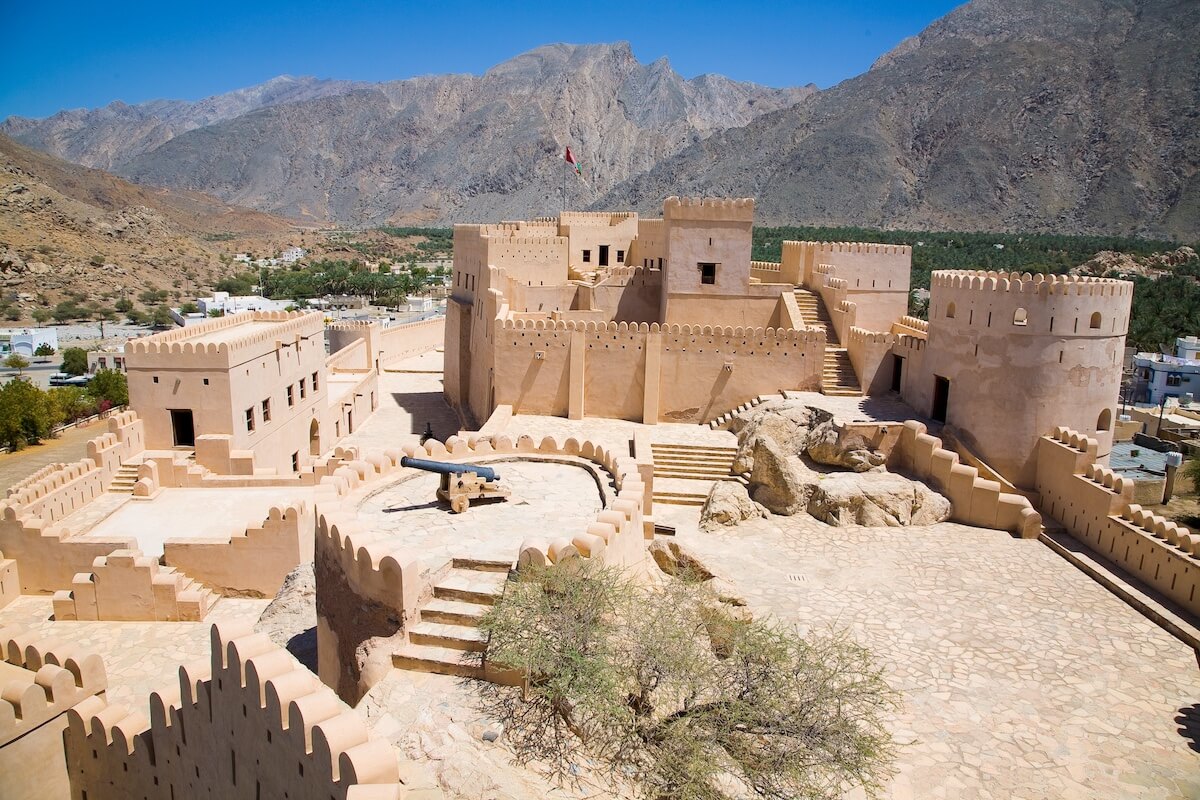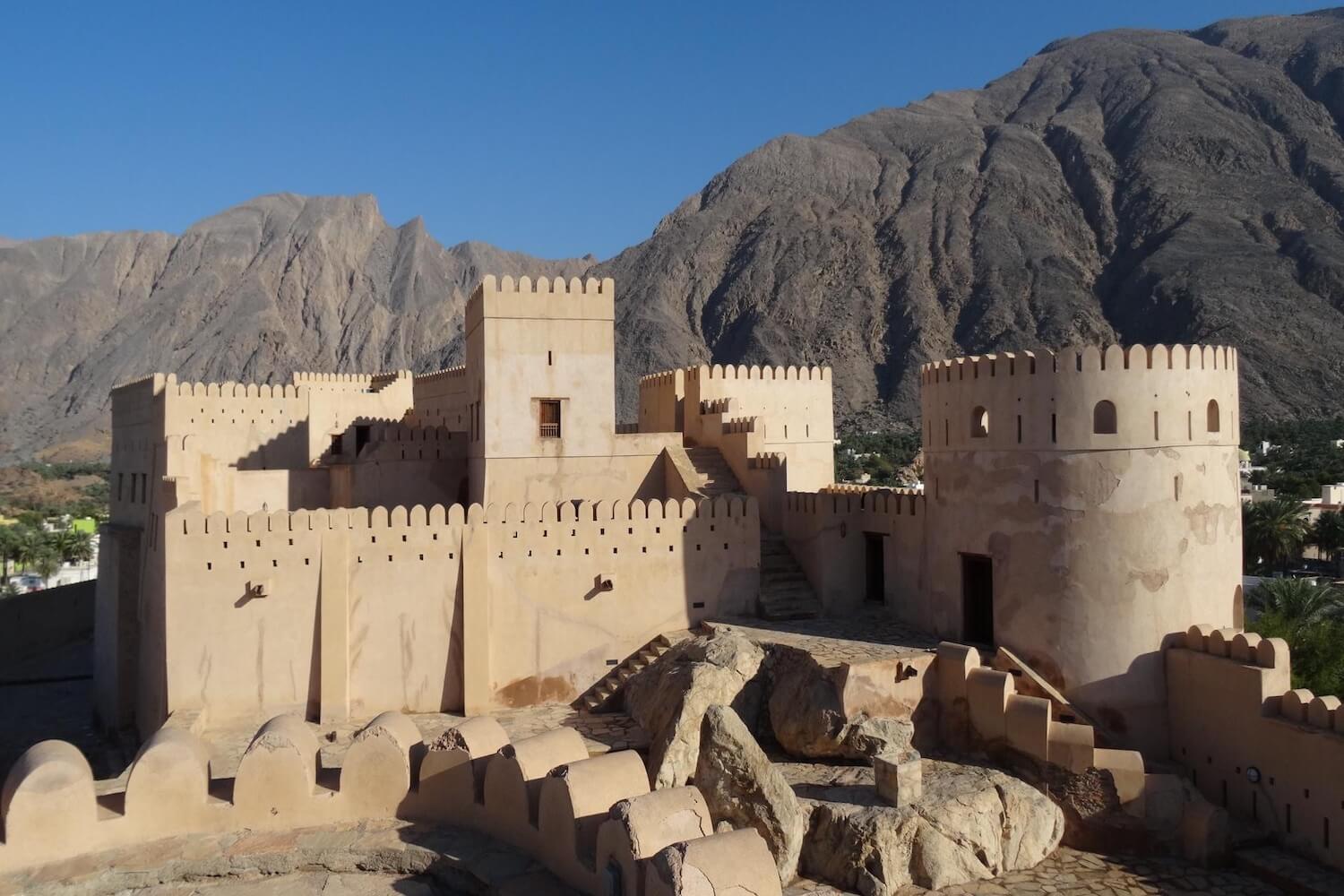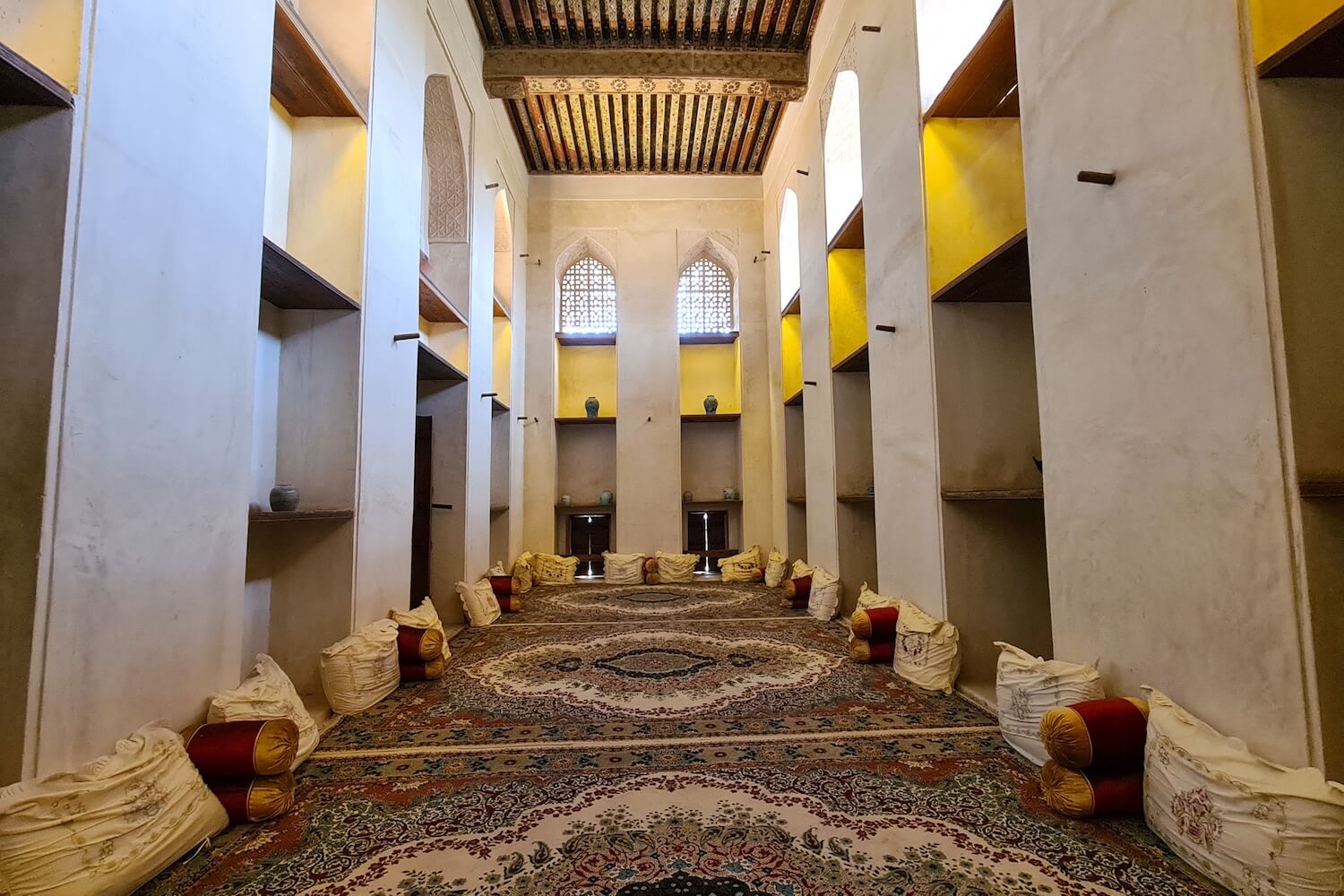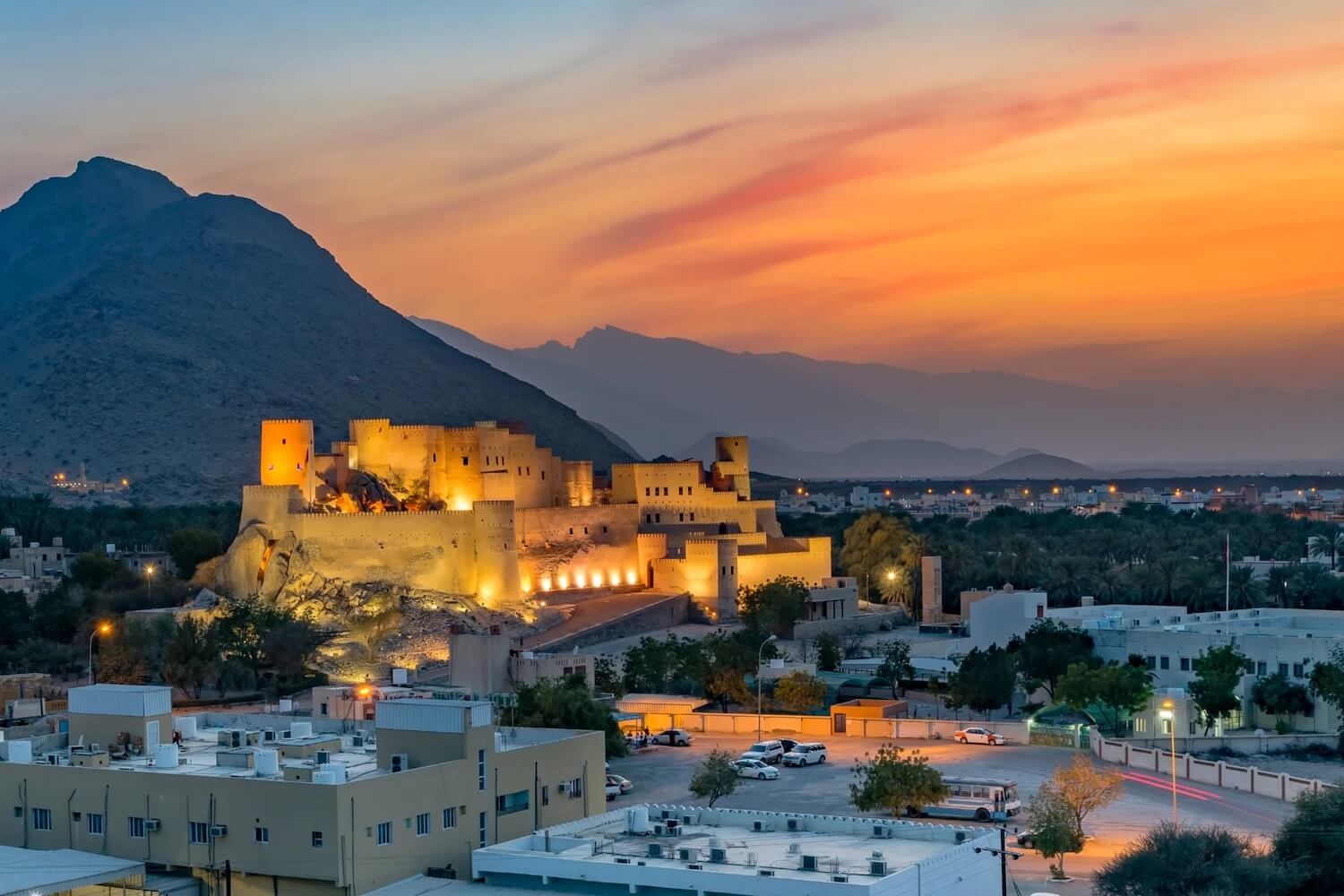Nakhal Fort, one of Oman’s most treasured historical landmarks, stands proudly in the heart of the Al Batinah region. Perched atop a rugged hill and enveloped by lush date palm groves, this imposing fortress has witnessed centuries of Oman’s history. Originally constructed over pre-Islamic foundations, Nakhal Fort has evolved through the ages, undergoing significant renovations, particularly during the reigns of the Yaruba and Al Bu Said dynasties. Its strategic location and historical importance make it a symbol of Oman’s military and cultural heritage.

The Historical Significance of Nakhal Fort
Nakhal Fort holds a pivotal place in Oman’s long and storied past. It has served not only as a formidable military stronghold but also as a key center for political and administrative power. Situated along ancient trade routes, it was crucial for protecting the region from invasions and securing the land. Throughout the centuries, it stood as a powerful testament to the resilience of the Omani people, who fortified their land against external threats. The fort has seen the rise and fall of empires, and its architectural evolution reflects the shifting tides of Oman’s history. The modifications made during the Yaruba and Al Bu Said dynasties have further cemented Nakhal Fort’s importance, shaping it into the striking structure we admire today.
Why Nakhal Fort is a Must-Visit Destination
For history enthusiasts, architecture lovers, and nature admirers, Nakhal Fort is an absolute must-visit. Not only does it offer a deep dive into Oman’s rich past, but it also provides sweeping panoramic views of the surrounding landscapes, from the expansive date palm groves to the distant mountains. The fort is an exemplary showcase of Omani military architecture, blending ancient techniques with the strategic needs of the time. It stands as a proud symbol of Oman’s heritage, embodying the country’s spirit of endurance and strength. A visit to Nakhal Fort offers an immersive experience, where one can connect with the past while soaking in the stunning natural beauty of the region.

The Architecture and Design of Nakhal Fort
Unique Structural Features
Nakhal Fort’s design is both functional and striking, with robust defensive walls that have withstood centuries of wear and tear. The fort’s watchtowers, standing tall on the rocky hill, offer an unrivaled view of the surrounding valleys and mountains, making it nearly impossible for any approaching invaders to go unnoticed. The fort’s design ensures that every element, from the high walls to the narrow staircases, contributes to its role as a defensive masterpiece. The integration of the fort into the natural rock formations around it further enhances its architectural uniqueness, blending the human-made with the natural in perfect harmony.
Defensive Mechanisms of the Fort
Nakhal Fort was constructed with defense at its core. Some of its most notable defensive features include:
High Walls and Towers: The imposing walls and strategically placed towers offered an ideal vantage point for spotting any potential threats. These elevated positions allowed defenders to see approaching enemies from miles away, giving them ample time to prepare.
Strategic Location: Perched atop a rocky hill, the fort’s location made it exceedingly difficult for enemies to launch an attack. Its natural elevation provided both protection and visibility, making it an ideal defensive site.
Narrow Passages and Hidden Chambers: Designed to enhance security, the fort features narrow passages and concealed chambers, offering defenders the ability to surprise and outmaneuver intruders. These intricate designs reflect the fort’s military ingenuity, ensuring its resilience through the centuries.
Interiors and Decorative Elements
Stepping inside Nakhal Fort, visitors are transported back in time, experiencing the grandeur and functional beauty of its interiors. The fort’s rooms are beautifully designed, with wooden doors adorned with intricate carvings and delicate patterns that reflect the skill of the Omani artisans of the era. Inside, traditional majlis areas, used for gatherings and important discussions, offer a glimpse into the social and political life of the time. A central courtyard sits at the heart of the fort, once the site of military strategy meetings and community gatherings. This space, surrounded by high walls and enclosed passageways, symbolizes the fort’s role as a hub of decision-making and defense. Every corner of the fort’s interior tells a story of its past, blending cultural tradition with the fort’s military purpose.

Things to Do in Al Batinah – Exploring Beyond Nakhal Fort
Visiting the Hot Springs of Nakhal
A short drive from Nakhal Fort leads to the renowned Nakhal Hot Springs, a perfect destination for relaxation and rejuvenation. Nestled amidst lush greenery, these natural thermal waters offer a serene environment, where both locals and tourists come to unwind. The warm waters, surrounded by the beauty of nature, provide a tranquil contrast to the rugged terrain of the fort. A visit to the hot springs offers a soothing respite and a chance to experience the natural beauty of Al Batinah.
Exploring Wadi Mistral and Wadi Bani Awf
For adventure seekers, Al Batinah is home to some of the most stunning wadis in Oman. Wadi Mistal and Wadi Bani Awf offer thrilling opportunities for hiking, swimming, and photography. These rugged, picturesque valleys are perfect for those who love outdoor exploration. The crystal-clear waters of the wadis, combined with the dramatic cliffs and lush greenery, make these locations ideal for nature lovers and adventurers alike.
Discovering the Bustling Souks and Local Markets
No trip to Al Batinah is complete without experiencing its traditional souks and vibrant local markets. These markets are alive with color and energy, offering a wide range of Omani handicrafts, spices, textiles, and fresh produce. Exploring these souks allows visitors to immerse themselves in the rich cultural fabric of the region, where they can interact with local artisans and purchase authentic Omani goods. Whether you’re looking for traditional silver jewelry, fragrant frankincense, or fresh dates, the souks offer a sensory experience like no other.

Historical Sites in Oman
Jabreen Castle – A Glimpse into Omani Royalty
Jabreen Castle, a stunning example of Omani architectural brilliance, transports visitors into the heart of the country’s royal past. Built in the 17th century by Imam Bil’arab bin Sultan, the castle features meticulously crafted halls adorned with beautiful frescoes and intricate carvings. It is not just an architectural wonder; the castle also served as a center of learning, with rooms dedicated to scholars and students, reflecting the region’s intellectual and cultural vibrancy. As you explore Jabreen Castle’s labyrinth of rooms, you’ll feel the legacy of Omani royalty and the rich traditions that shaped the nation’s history.

Bahla Fort – A UNESCO World Heritage Site
Bahla Fort, a UNESCO World Heritage site, stands as a monumental testament to Oman’s ancient fortification methods. With its expansive walls, towering structures, and strategic design, Bahla Fort offers a fascinating glimpse into Oman’s military history, dating back to the pre-Islamic period. The fort’s construction, using mudbrick and stone, makes it one of the oldest and most impressive examples of traditional Omani architecture. Surrounded by palm groves and expansive landscapes, Bahla Fort not only serves as a key historical site but also provides a stunning backdrop for photography, evoking the beauty of Oman’s past and its resilient people.

Nizwa Fort – The Cultural Heart of Oman
At the heart of Oman’s cultural heritage lies Nizwa Fort, a masterpiece of military architecture. This imposing fort features a massive cylindrical tower that once served as the center of the town’s defense system. Nizwa Fort offers a window into the region’s historical significance, showcasing traditional Omani warfare tactics and the region’s role in Oman’s past. Inside, visitors can explore its defensive features, such as secret escape routes, and gain an understanding of how the fort played a vital role in the protection of the town. Nizwa itself, with its bustling souk and vibrant culture, is a perfect complement to the fort, offering visitors a glimpse into Oman’s historical heart.

How to Plan Your Visit to Nakhal Fort
Best Time to Visit Nakhal Fort
The best time to explore Nakhal Fort is between October and April, when the weather is cooler and more conducive to outdoor exploration. During these months, the temperatures are comfortable, allowing visitors to fully appreciate the stunning panoramic views and immerse themselves in the fort’s history. Avoid the hotter summer months, as temperatures can soar, making outdoor exploration less enjoyable.
Getting to Nakhal Fort
Nakhal Fort is located approximately 120 km from Muscat, making it an easy day trip for travelers. The fort is accessible by well-maintained roads, and the drive offers a chance to see Oman’s beautiful countryside, with date palm plantations and rugged mountains lining the route. Renting a car is the most convenient option for reaching Nakhal Fort, as it allows you to explore the surrounding region at your own pace and visit other nearby attractions.

Entrance Fees and Visiting Hours
Entrance Fee: The fort is either free to enter or requires a minimal fee (this may vary, so it’s a good idea to check for any changes before your visit).
Visiting Hours: Nakhal Fort is generally open from 9 AM to 4 PM, offering ample time for exploration. However, it’s always advisable to confirm the hours in advance, especially during holidays or special events.
Tips for Visitors
As Nakhal Fort is a cultural and historical site, it’s essential to dress modestly and respect local customs. Lightweight, comfortable clothing is recommended, but it’s important to cover shoulders and knees.
The fort offers stunning views of the surrounding landscape, including the date palm groves and the rugged mountains. Don’t forget your camera to capture these breathtaking scenes!
To avoid the midday heat and get the best lighting for photographs, plan your visit either early in the morning or late in the afternoon. The soft, golden light of the early morning or late afternoon adds a magical touch to the scenery, making for unforgettable memories.


0 Comment